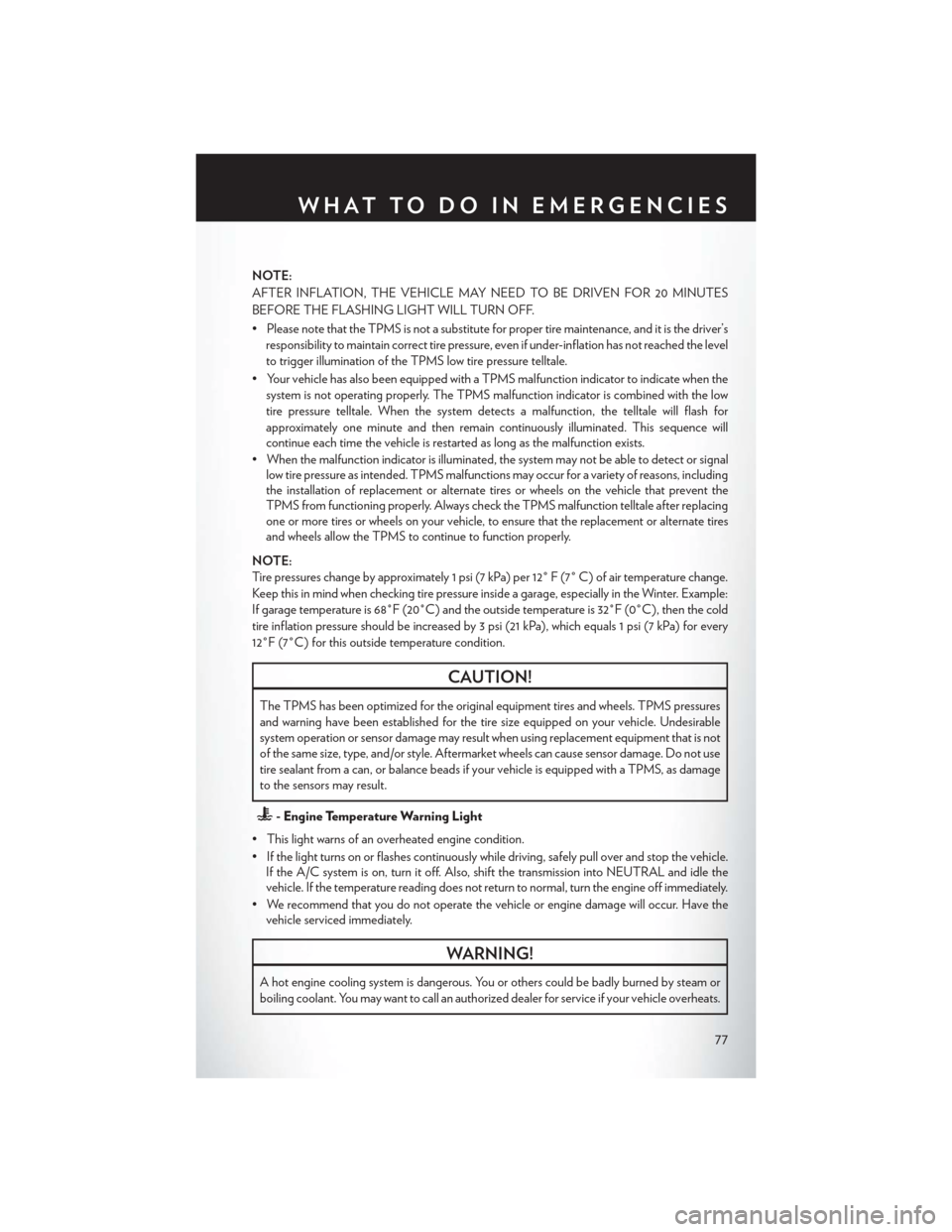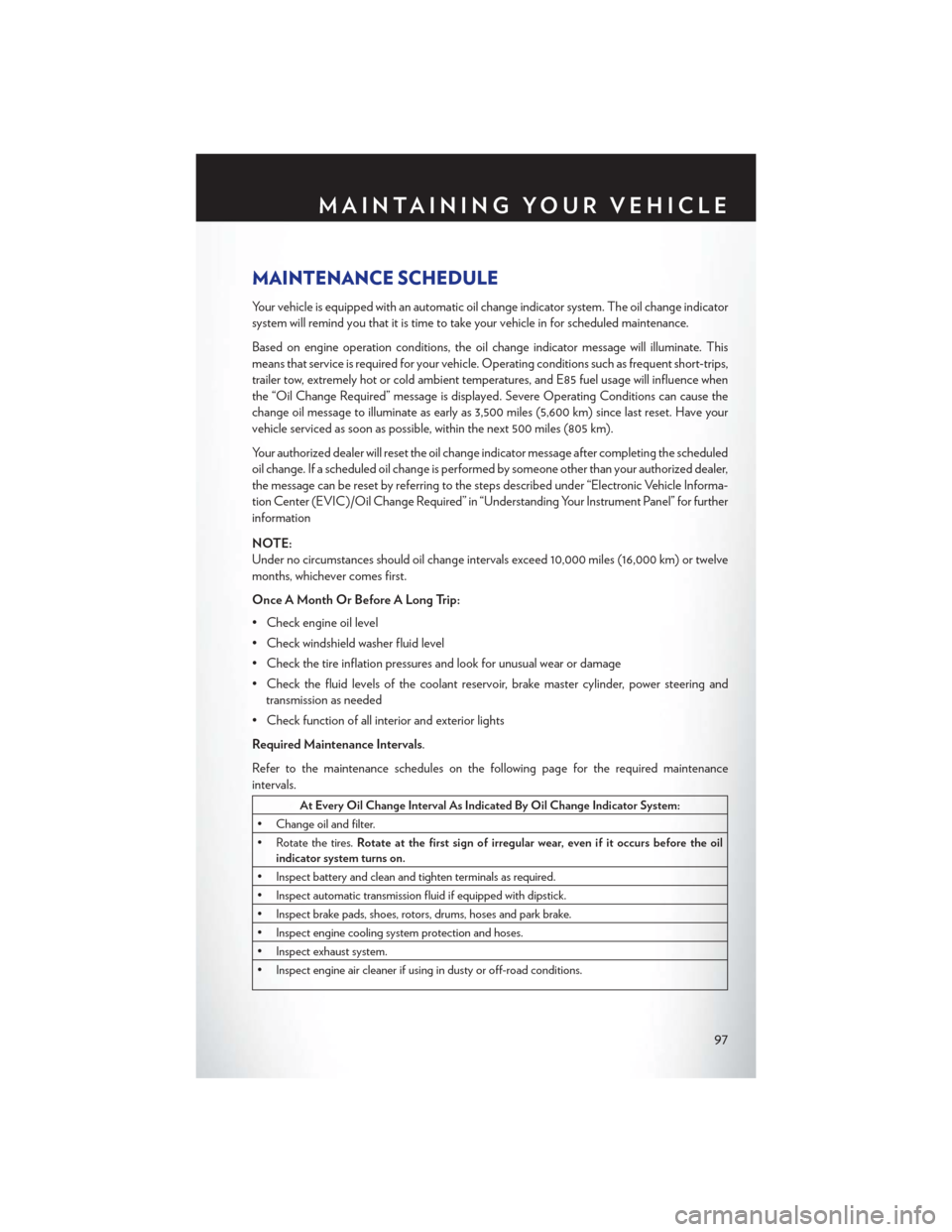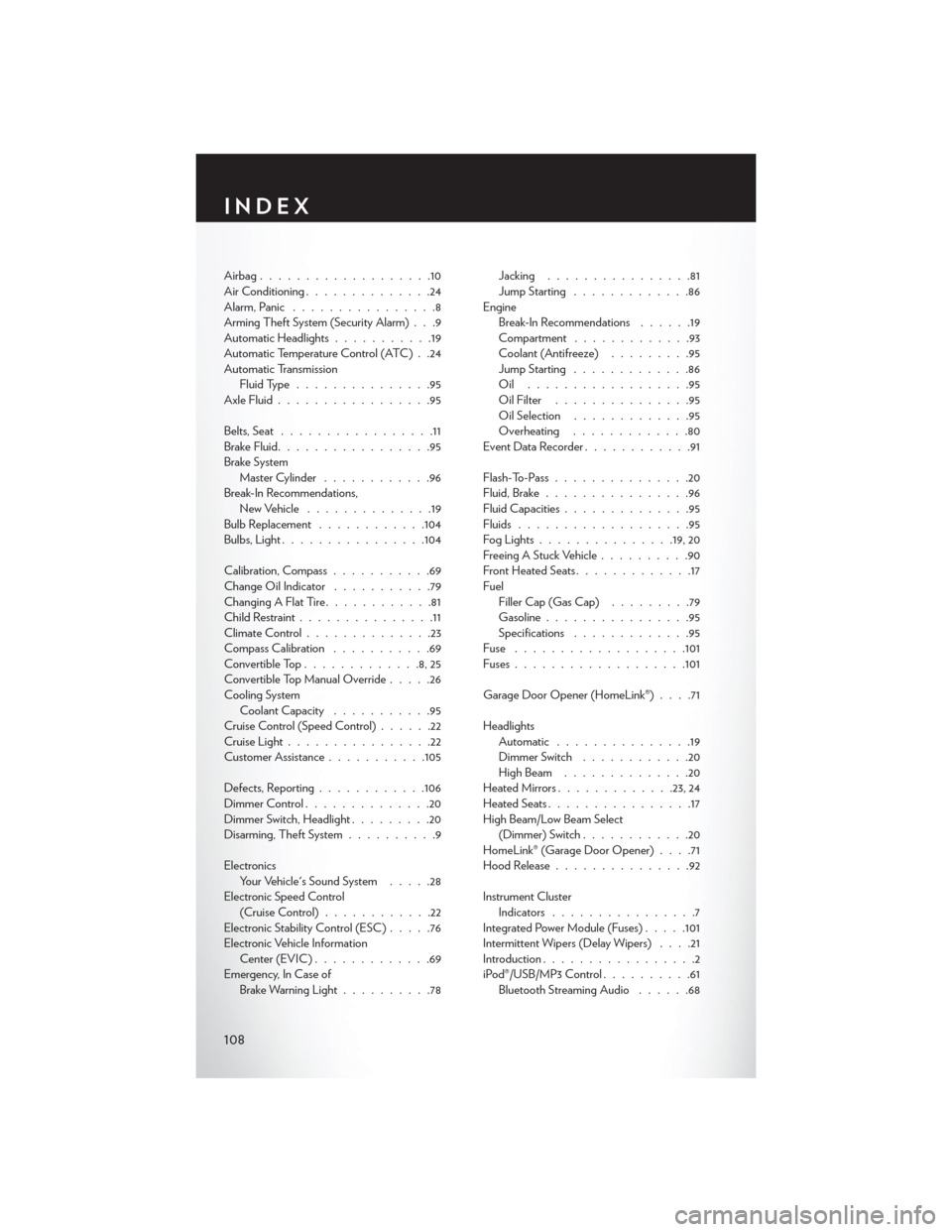engine coolant CHRYSLER 200 CONVERTIBLE 2013 1.G User Guide
[x] Cancel search | Manufacturer: CHRYSLER, Model Year: 2013, Model line: 200 CONVERTIBLE, Model: CHRYSLER 200 CONVERTIBLE 2013 1.GPages: 116, PDF Size: 3.04 MB
Page 79 of 116

NOTE:
AFTER INFLATION, THE VEHICLE MAY NEED TO BE DRIVEN FOR 20 MINUTES
BEFORE THE FLASHING LIGHT WILL TURN OFF.
• Please note that the TPMS is not a substitute for proper tire maintenance, and it is the driver’sresponsibility to maintain correct tire pressure, even if under-inflation has not reached the level
to trigger illumination of the TPMS low tire pressure telltale.
• Your vehicle has also been equipped with a TPMS malfunction indicator to indicate when the system is not operating properly. The TPMS malfunction indicator is combined with the low
tire pressure telltale. When the system detects a malfunction, the telltale will flash for
approximately one minute and then remain continuously illuminated. This sequence will
continue each time the vehicle is restarted as long as the malfunction exists.
• When the malfunction indicator is illuminated, the system may not be able to detect or signal low tire pressure as intended. TPMS malfunctions may occur for a variety of reasons, including
the installation of replacement or alternate tires or wheels on the vehicle that prevent the
TPMS from functioning properly. Always check the TPMS malfunction telltale after replacing
one or more tires or wheels on your vehicle, to ensure that the replacement or alternate tires
and wheels allow the TPMS to continue to function properly.
NOTE:
Tire pressures change by approximately 1 psi (7 kPa) per 12° F (7° C) of air temperature change.
Keep this in mind when checking tire pressure inside a garage, especially in the Winter. Example:
If garage temperature is 68°F (20°C) and the outside temperature is 32°F (0°C), then the cold
tire inflation pressure should be increased by 3 psi (21 kPa), which equals 1 psi (7 kPa) for every
12°F (7°C) for this outside temperature condition.
CAUTION!
The TPMS has been optimized for the original equipment tires and wheels. TPMS pressures
and warning have been established for the tire size equipped on your vehicle. Undesirable
system operation or sensor damage may result when using replacement equipment that is not
of the same size, type, and/or style. Aftermarket wheels can cause sensor damage. Do not use
tire sealant from a can, or balance beads if your vehicle is equipped with a TPMS, as damage
to the sensors may result.
- Engine Temperature Warning Light
• This light warns of an overheated engine condition.
• If the light turns on or flashes continuously while driving, safely pull over and stop the vehicle. If the A/C system is on, turn it off. Also, shift the transmission into NEUTRAL and idle the
vehicle. If the temperature reading does not return to normal, turn the engine off immediately.
• We recommend that you do not operate the vehicle or engine damage will occur. Have the vehicle serviced immediately.
WARNING!
A hot engine cooling system is dangerous. You or others could be badly burned by steam or
boiling coolant. You may want to call an authorized dealer for service if your vehicle overheats.
WHAT TO DO IN EMERGENCIES
77
Page 82 of 116

IF YOUR ENGINE OVERHEATS
• In any of the following situations, you can reduce the potential for overheating by taking theappropriate action.• On the highways — slow down.
• In city traffic — while stopped, shift transmission into NEUTRAL, but do not increase engine
idle speed.
NOTE:
There are steps that you can take to slow down an impending overheat condition:
• If your air conditioner (A/C) is on, turn it off. The A/C system adds heat to the engine cooling system and turning the A/C off can help remove this heat.
• You can also turn the Temperature Control to maximum heat, the Mode Control to floor and the Fan Control to high. This allows the heater core to act as a supplement to the radiator and
aids in removing heat from the engine cooling system.
• If the temperature reading does not return to normal, turn the engine off immediately.
• We recommend that you do not operate the vehicle or engine damage will occur. Have the vehicle serviced immediately.
Engine Oil Overheating — 2.4L Gas
• On hot days the engine oil temperature may become too hot during sustained high-speed driving or if towing a trailer up long grades. If this happens, a HOTOIL message will flash in the
odometer and the vehicle speed will be reduced to 48 mph (77 km/h) maximum until the
engine oil temperature is reduced.
NOTE:
Although the maximum vehicle speed is reduced to 48 mph (77 km/h), you may reduce vehicle
speed further as needed. Once the engine oil temperature is reduced, you may continue to drive
normally.
CAUTION!
Driving with a hot cooling system could damage your vehicle. If the temperature gauge reads
HOT (H), pull over and stop the vehicle. Idle the vehicle with the air conditioner turned off
until the pointer drops back into the normal range. If the pointer remains on HOT (H), and
you hear continuous chimes, turn the engine off immediately, and call for service.
WARNING!
You or others can be badly burned by hot engine coolant (antifreeze) or steam from your
radiator. If you see or hear steam coming from under the hood, do not open the hood until the
radiator has had time to cool. Never try to open a cooling system pressure cap when the
radiator or coolant bottle is hot.
WHAT TO DO IN EMERGENCIES
80
Page 97 of 116

FLUIDS AND CAPACITIES
ComponentFluid, Lubricant, or Genuine Part Capacities
Engine Coolant–
2.4L Engine We recommend you use MOPAR®
Antifreeze/Coolant 10 Year/
150,000 Mile Formula OAT
(Organic Additive Technology). 7.7 Quarts (7.3 Liters) Includes
heater and coolant recovery
bottle filled to MAX level.
Engine Coolant–
3.6L Engine We recommend you use MOPAR®
Antifreeze/Coolant 10 Year/
150,000 Mile Formula OAT
(Organic Additive Technology). 11.6 Quarts (11 Liters) Includes
heater and coolant recovery
bottle filled to MAX level.
Engine Oil with Filter–
2.4L Engine We recommend you use API Certi-
fied SAE 5W-20 engine oil, meet-
ing the requirements of Chrysler
Material Standard MS-6395. Refer
to the engine oil filler cap for cor-
rect SAE grade. 4.5 Quarts (4.4 Liters)
Engine Oil with Filter–
3.6L Engine
We recommend you use API
Certified SAE 5W-20 engine oil,
meeting the requirements of
Chrysler Material Standard
MS-6395. Refer to your engine oil
filler cap for correct SAE grade.6 Quarts (5.6 Liters)
Fuel Selection –
All Engines
(Except 2.4L PZEV) 87 Octane
16.9 Gallons (64 Liters)
(Approximate)
Fuel Selection– 2.4L
PZEV Engine 87 Octane
18.5 Gallons (70 Liters)
(Approximate)
Engine Oil Filter We recommend you use MOPAR® brand Engine Oil Filters. —
Spark Plugs 2.4L– Except
PZEV Engine
We recommend you use MOPAR®
Spark Plugs (Gap 0.043 in [1.1 mm]).—
Spark Plugs 2.4L– With
PZEV Engine
We recommend you use MOPAR®
Spark Plugs (Gap 0.031 in [0.8 mm]).—
Spark Plugs– 3.6L Engine
We recommend you use MOPAR®
Spark Plugs (Gap 0.043 in [1.1 mm]).—
Automatic Transmission
We recommend youONLY use
MOPAR® ATF+4® Automatic
Transmission Fluid.
Failure to use ATF+4 fluid may
affect the function or performance
of your transmission.—
MAINTAINING YOUR VEHICLE
95
Page 98 of 116

ComponentFluid, Lubricant, or Genuine Part Capacities
Brake Master Cylinder We recommend you use MOPAR® DOT 3 and SAE J1703. If DOT 3
is not available, then DOT 4 is
acceptable. —
Power Steering Reservoir We recommend you use MOPAR®
Power Steering Flui d+4or
MOPAR® ATF+4® Automatic Transmission Fluid. —
CAUTION!
• Mixing of engine coolant (antifreeze) other than specified Organic Additive Technology
(OAT) engine coolant (antifreeze), may result in engine damage and may decrease
corrosion protection. Organic Additive Technology (OAT) engine coolant is different
and should not be mixed with Hybrid Organic Additive Technology (HOAT) engine
coolant (antifreeze) or any “globally compatible” coolant (antifreeze). If a non-OAT
engine coolant (antifreeze) is introduced into the cooling system in an emergency, it
should be flushed with OAT coolant and replaced with the specified OAT engine coolant
(antifreeze) as soon as possible.
• Do not use water alone or alcohol-based engine coolant (antifreeze) products. Do not use
additional rust inhibitors or antirust products, as they may not be compatible with the
radiator engine coolant and may plug the radiator.
•
This vehicle has not been designed for use with propylene glycol-based engine coolant
(antifreeze). Use of propylene glycol-based engine coolant (antifreeze) is not recommended.
E85 FLEXIBLE FUEL — 3.6L ENGINE ONLY
Refer to your Owner's Manual on the DVD for further details.
CAUTION!
Only vehicles with the E-85 fuel filler door label or a yellow gas cap can operate on E-85.
MAINTAINING YOUR VEHICLE
96
Page 99 of 116

MAINTENANCE SCHEDULE
Your vehicle is equipped with an automatic oil change indicator system. The oil change indicator
system will remind you that it is time to take your vehicle in for scheduled maintenance.
Based on engine operation conditions, the oil change indicator message will illuminate. This
means that service is required for your vehicle. Operating conditions such as frequent short-trips,
trailer tow, extremely hot or cold ambient temperatures, and E85 fuel usage will influence when
the “Oil Change Required” message is displayed. Severe Operating Conditions can cause the
change oil message to illuminate as early as 3,500 miles (5,600 km) since last reset. Have your
vehicle serviced as soon as possible, within the next 500 miles (805 km).
Your authorized dealer will reset the oil change indicator message after completing the scheduled
oil change. If a scheduled oil change is performed by someone other than your authorized dealer,
the message can be reset by referring to the steps described under “Electronic Vehicle Informa-
tion Center (EVIC)/Oil Change Required” in “Understanding Your Instrument Panel” for further
information
NOTE:
Under no circumstances should oil change intervals exceed 10,000 miles (16,000 km) or twelve
months, whichever comes first.
Once A Month Or Before A Long Trip:
• Check engine oil level
• Check windshield washer fluid level
• Check the tire inflation pressures and look for unusual wear or damage
• Check the fluid levels of the coolant reservoir, brake master cylinder, power steering andtransmission as needed
• Check function of all interior and exterior lights
Required Maintenance Intervals.
Refer to the maintenance schedules on the following page for the required maintenance
intervals.
At Every Oil Change Interval As Indicated By Oil Change Indicator System:
• Change oil and filter.
• Rotate the tires. Rotate at the first sign of irregular wear, even if it occurs before the oil
indicator system turns on.
• Inspect battery and clean and tighten terminals as required.
• Inspect automatic transmission fluid if equipped with dipstick.
• Inspect brake pads, shoes, rotors, drums, hoses and park brake.
• Inspect engine cooling system protection and hoses.
• Inspect exhaust system.
• Inspect engine air cleaner if using in dusty or off-road conditions.
MAINTAINING YOUR VEHICLE
97
Page 100 of 116

Maintenance Chart
Mileage or time passed
(whichever comes first)
20,000
30,000
40,000 50,000
60,000
70,000
80,000 90,000
100,000
110,000
120,000 130,000
140,000 150,000
Or Years: 2 3 4 5 6 7 8 9 10 11 12 13 14 15
Or Kilometers:
32,000
48,000
64,000
80,000
96,000
112,000
128,000
144,000
160,000
176,000
192,000
208,000 224,000
240,000
Additional Inspections
Inspect the CV joints. X X X X X
Inspect front suspension, tie rod ends, boot
seals and replace if necessary.
XXX X X X X
Inspect the brake linings, parking brake function.
XXX X X X X
Additional Maintenance
Replace engine air filter. XX X X X
Replace cabin/air conditioning filter. XXX X X XX
Replace spark plugs (2.4L Engine). ** XX X X X
Replace spark plugs (2.4L PZEV Engine Only). **
X
Replace spark plugs (3.6L Engine). ** X
Flush and replace the engine coolant at
10 years or 150,000 miles (240,000 km)
whichever comes first. XX
MAINTAINING YOUR VEHICLE
98
Page 110 of 116

Airbag...................10
Air Conditioning..............24
Alarm, Panic ................8
Arming Theft System (Security Alarm) . . .9
Automatic Headlights ...........19
Automatic Temperature Control (ATC) . .24
Automatic Transmission Fluid Type ...............95
Axle Fluid .................95
Belts, Seat .................11
Brake Fluid .................95
Brake System Master Cylinder ............96
Break-In Recommendations, New Vehicle ..............19
Bulb Replacement ............104
Bulbs,Light................104
Calibration, Compass ...........69
Change Oil Indicator ...........79
Changing A Flat Tire ............81
Child Restraint ...............11
Climate Control ..............23
Compass Calibration ...........69
Convertible Top .............8,25
Convertible Top Manual Override .....26
Cooling System Coolant Capacity ...........95
Cruise Control (Speed Control) ......22
Cruise Light ................22
Customer Assistance ...........105
Defects, Reporting ............106
Dimmer Control ..............20
Dimmer Switch, Headlight .........20
Disarming, Theft System ..........9
Electronics Your Vehicle's Sound System .....28
Electronic Speed Control (Cruise Control) ............22
Electronic Stability Control (ESC) .....76
Electronic Vehicle Information Center (EVIC) .............69
Emergency, In Case of Brake Warning Light ..........78 Jacking
................81
Jump Starting .............86
Engine Break-In Recommendations ......19
Compartment .............93
Coolant (Antifreeze) .........95
Jump Starting .............86
Oil ..................95
Oil Filter ...............95
Oil Selection .............95
Overheating .............80
EventDataRecorder............91
Flash-To-Pass ...............20
Fluid, Brake ................96
Fluid Capacities ..............95
Fluids ...................95
F
ogLights...............19, 20
Freeing A Stuck Vehicle ..........90
Front Heated Seats .............17
Fuel Filler Cap (Gas Cap) .........79
Gasoline ................95
Specifications .............95
Fuse ...................101
Fuses .................. .101
Garage Door Opener (HomeLink®) ....71
Headlights Automatic ...............19
Dimmer Switch ............20
HighBeam ..............20
Heated Mirrors ............ .23, 24
Heated Seats ................17
High Beam/Low Beam Select (Dimmer) Switch ............20
HomeLink® (Garage Door Opener) ....71
Hood Release ...............92
Instrument Cluster Indicators ................7
Integrated Power Module (Fuses) .....101
Intermittent Wipers (Delay Wipers) ....21
Introduction .................2
iPod®/USB/MP3 Control ..........61
Bluetooth Streaming Audio ......68
INDEX
108